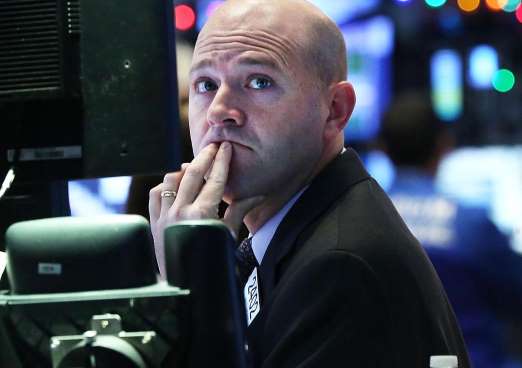January 4, 2016
NEW YORK – Stocks traded sharply lower Monday, the first day of trade for the year, weighed by renewed concerns of global economic slowdown and increased tensions in the Middle East. The overnight drop in Chinese stocks that triggered a circuit breaker also pressured sentiment.

January 4, 2016
NEW YORK – Stocks traded sharply lower Monday, the first day of trade for the year, weighed by renewed concerns of global economic slowdown and increased tensions in the Middle East. The overnight drop in Chinese stocks that triggered a circuit breaker also pressured sentiment.

The Dow Jones industrial average briefly fell more than 450 points, down more than 2.5 percent, on pace for its largest percent decline on the first trading day of the year since 1932. The Dow also fell below the psychologically key 17,000 level in intraday trade.
U.S. data reaffirmed concerns about global manufacturing. The U.S. December ISM Manufacturing Index was 48.2, below expectations and down from November's 48.6 print.
"That's not helping because last week we had a couple more minor PMI readings and they showed the same thing," said Mark Luschini, chief investment strategist at Janney Montgomery Scott.
Last Thursday, the Chicago PMI came in at 42.9 for December, down from 48.7 in November.
The Nasdaq composite traded more than 3 percent lower. Apple fell more than 2 percent in morning trade.
The S&P 500 dropped more than 2.5 percent and fell below the psychologically key 2,000 level in intraday trade.
"We took out 2,000 on the S&P 500 and 17,000 on the Dow. That (may be) creating some levels for some selling going down," said Peter Coleman, head trader at Convergex.
Information technology and financials fell more than 2.5 percent in morning trade to lead most S&P 500 sectors lower. Energy briefly attempted gains as oil initially tried to bounce.
Tesla and Chinese e-commerce site JD.com fell more than 7.5 percent in mid-morning trade as the greatest decliners in the Nasdaq 100.
"A lot of it has to do with China and a lot of it is overdone," said Art Hogan, chief market strategist at Wunderlich Securities. "The China PMI hasn't changed much. It's not unusual to have an outsized reaction when you've got a base case that 2016 could be a tough year."
"I think it's very much global markets are in a risk-off mode. It's very hard to step in the way of (that)," he said.
What will have a larger impact on stocks in 2016?
Dow futures were down more than 300 points prior to the market open. European stocks also traded deep in the red, with the DAX more than 4 percent lower and the STOXX Europe 600 off about 2.4 percent as of 10:28 a.m., ET.
Oil traded mixed amid increased tension in the Middle East, with WTI turning lower below $37 a barrel and Brent up 0.3 percent around $37.40 a barrel as of 11:13 a.m., ET.
Saudi Arabia, the world's biggest oil exporter, cut diplomatic ties with Iran on Sunday in response to the storming of its embassy in Tehran. The protest followed Saudi Arabia's execution of a prominent Shi'ite cleric.
Chinese stocks plunged Monday after Caixin manufacturing PMI showed continued contraction in that area of the economy.
Traders also reduced positions in small caps ahead of the Friday expiration of a six-month selling ban imposed on the major shareholders of listed companies, StreetAccount said. The Chinese yuan also weakened to hit its lowest since 2011.
The Shanghai and Shenzhen exchanges ended the trading session early after the CSI 300 dropped 7 percent, triggering a circuit breaker. The halt was the first implementation of the new circuit breaker rule announced September.
China's Shanghai composite lost nearly 6.9 percent for its worst day since Aug. 25, 2015.
Over the weekend, China reported manufacturing PMI that remained below the 50 level that indicates contraction. The official manufacturing PMI for December was 49.7 after posting 49.6 in November, while the Caixin December manufacturing PMI was 48.2 versus November's 48.6.
The official services PMI edged higher to 54.4 from 53.6 the prior month.
In other U.S. economic news, the December U.S. Market manufacturing PMI was 51.2. Construction spending fell 0.4 percent in November.
Treasury yields hit their lowest levels in a week. The 2-year yield held near 1.03 percent and the 10-year yield was around 2.22 percent as of 10:30 a.m., ET.
The U.S. dollar traded a touch higher against major world currencies, with the euro near $1.08 and the yen at 119.24 yen against the greenback.
Gold traded more than 1.5 percent higher to hit its highest level in almost two weeks.
U.S. stocks closed lower Thursday, the last day of trade for 2015. The S&P 500 and Dow Jones industrial average posted losses for the year, their worst annual performance since 2008.
The Russell 2000 and Dow transports also had their worst year in seven.
The Nasdaq composite ended more than 5.5 percent higher for 2015, helped by outperformance in biotech stocks and major tech names, except Apple. The iPhone maker's stock turned in its first negative year since 2008.
The CBOE Volatility Index (VIX), widely considered the best gauge of fear in the market, topped 23 to hit its highest level in two weeks.
About six stocks declined for every advancer on the New York Stock Exchange, with an exchange volume of 112 million and a composite volume of 390 million.
Crude oil futures for February delivery gained 92 cents to $37.97 a barrel on the New York Mercantile Exchange. Gold futures for February delivery rose $17 to $1,077.20 an ounce as of 9:41 a.m., ET.
Courtesy: CNBC
















































































































